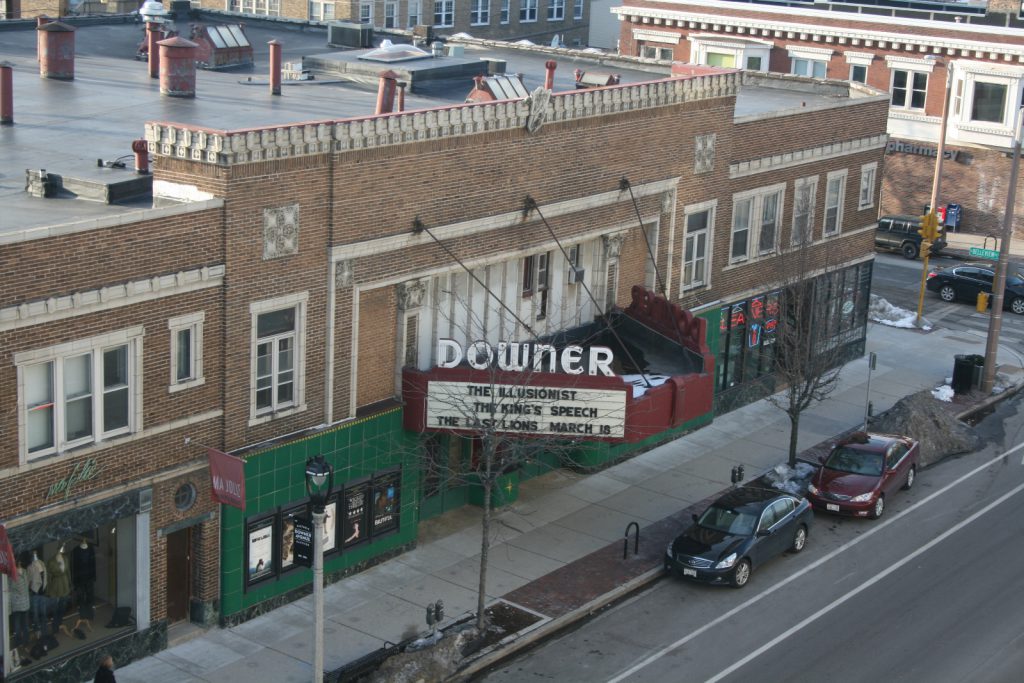Downer Theatre is Street’s Anchor
Opened in 1915, survived the silent era, the oldest still operating movie theater in Milwaukee.
The first week of December is Downer Avenue Week here at Urban Milwaukee, and it’s worthy of note that the street’s most significant structure celebrates its 103rd anniversary at the same time.
The Landmark Downer Theatre, 2587 N. Downer Ave., opened to the public on Friday, December 3rd, 1915 with a showing of the motion picture Seven Sisters, a wholesome romantic comedy, now presumed lost. This programming was certainly within the scope promised in an opening day advertisement, which extolled the house’s “Amusing, Clean Comedies.” Potential customers at the East Side cinema were also told to expect the “Best feature photo plays,” (changed daily), “interesting and instructive travelogues,” and the highbrow “‘Downer Topics of the Day’ illustrating current events.” Most were to be accompanied by “instrumental music, including organ,” provided by the house band.
This was back in the days when movies did not make their own sound effects, since the projections were silent, thus the need for an orchestra and a powerful organ to really lay it on when the damsel is being tied to the railroad track by the heartless villain. The instrument was provided by the Wangerin-Weickhardt Organ Company, which was located on S. Burrell St. in Milwaukee.
Oldest Operating Cinema in Milwaukee
Although it was not the first theater in Milwaukee built expressly for motion pictures, (that would be the 1907 Astor Theater, now Glorioso’s Italian Market, 1011 E. Brady St.) the Landmark Downer is the oldest still-running movie house in Milwaukee, eclipsing the screen at the Oriental by 12 years. It is operated by Landmark Theatres, “the United States’ largest theater chain dedicated to exhibiting and marketing independent and foreign films.”
It was Milwaukee’s first “art house” cinema, dating as far back as the 1940s, and aided and abetted by its location near the university, and the prosperous gentry of the East Side. The transformation into an art house is also a testament to the relatively intimate character of the “neighborhood theater” at a time when motion picture “palaces” booked the big Hollywood features. Later the art house formula helped to guarantee the survival of the Downer as further competition came in the form of giant cineplexes located in high volume shopping districts, and as other neighborhood theaters succumbed to changes in popular entertainment, with television being the most prominent. The theater was split into two screens (left and right) after Landmark leased it in 1989, which also helped to ensure its vitality. It was by no means a given that the theater would survive, and with it, a vibrant shopping district.
According to a Historic Designation Study Report authored by the late Paul Jakubovich of the City of Milwaukee,
…it occupies a unique niche in the architectural history of Milwaukee’s movie theatres. Built more than twelve years before the advent of ‘talking pictures,’ the theatre is one of the few in the metropolitan area that made the transition from silent pictures to sound pictures and still survives, basically intact, today. … Today the Downer is not only a rare survivor from the silent film era, but it is also an outstanding example of how an older theatre can be successfully adapted to meet the needs of the modern marketplace.
The Downer opened in the same year as Birth of a Nation initiated the concept of the “Hollywood Blockbuster” causing the demise of the old Nickelodeons housed in storefronts. The real big shows would go to the real big theaters, with the boom in the movie palaces dating to shortly after the Downer opened. In retrospect, it is quite an accomplishment that the Downer was able to survive into the “Talking Picture’ era, much less to remain vibrant and profitable in an era when nearly everybody carries a device that can screen the latest picture. It would be nice to bring back the Downer Topics of the Day, though.
A “Chicago Commercial Style” Structure on the East Side
The Downer was built at a cost of $55,000 and was designed by the Milwaukee firm of Martin Tullgren & Sons (Herbert and Minard, were their names.) Tullgren gave us the streamlined Viking Apartments, the sedate Astor Hotel, and the “Art Deco Building” at 1260 N. Prospect Ave. The versatile architects also gave us the Spanish Revival Bertelson Building, 2109 N. Prospect Ave., a touch of Santa Barbara on the Lower East Side.
The theater is the only remaining Milwaukee example of a structure in the “Chicago Commercial Style,” according to the study report cited above.
The Downer Theatre is a fine example of the Chicago Commercial Style of architecture and it is the oldest known theater still operating in the City of Milwaukee. The two-story, symmetrically composed, flat roofed brick structure features a central bay that contains the theatre entrance and a massive, projecting, Art Deco Style marquee. Flanking the theatre entrance on either side are retail storefronts.
The building is trimmed with extensive terra cotta ornament that is reminiscent of the design work of Chicago architect Louis Sullivan. The marquee is a replacement for the original one and the green enameled steel panels that surround the entry also apparently date from a 1930s remodeling. Because these alterations have acquired a historic character of their own over the years they are considered a contributing part of the structure and are worthwhile to preserve.
A Streetcar at the Front Door
With about 6,000 residents within its borders, the Murray Hill neighborhood surrounding the Downer has a density of about 22,000 people per square mile, which ranks it third in the city. The development of the area was not immediate. An inspection of maps from 1896 and 1910, linked below, shows two homes on the site of what would be the theater, and many vacant lots on the block, and even in the upscale blocks between it and Lake Michigan.
Yet it was clear to early developers that the area, about three miles northeast of City Hall, would have a primarily residential character. This was in contrast to much of Milwaukee, where industry and homes often coexisted for better or worst. Today there is only one significant factory building on the East Side, and that is the Wisconsin Paperboard Co., located on the banks of the Milwaukee River north of E. North Ave.
In the pre-supermarket days of 1915, such residential neighborhoods would be served by a variety of merchants, such as grocers, bakeries, butchers, confectioners, usually located in their own storefronts (sometimes living above) and with a clientele mostly from the immediate vicinity. Even in wealthier areas such as this one, most transit was by bus and rail. Automobiles were still relatively expensive and difficult to maintain.
The theater occupies only 8,781 square feet of its 51,045-square-foot structure, although with its marquee, it does tend to dominate the structure, which includes such attractions as Pizza Man and Henry’s.
Even today, Downer Avenue boasts an independent bakery, a specialty grocer, a locally owned bookstore, an upscale liquor store, and a surviving example of the increasingly rare neighborhood hardware store. At one time or another, this structure which originally included 6 stores and 8 apartments, has housed examples of each type of these businesses, with the theater, of course being the constant.
Taken with its neighborhood theater, also a rarity these days, Downer Avenue is a vital commercial district that should serve as a model for similar neighborhoods in Milwaukee that were also once on a streetcar line — and perhaps will be again. If the streetcar, as projected, is to someday reach UW-Milwaukee, this street would provide a very likely route, and the Downer Theatre will prove to be a fine destination.
There are numerous sources of information on the Downer Theatre, including those linked below.
In addition, Urban Milwaukee: The Store has numerous histories of Milwaukee theaters in stock.
- Milwaukee Public Library: 100 Years of Movie Magic at the Downer
- Bobby Tanzilo article on Downer Theatre centennial, OnMilwaukee.com.
- Murray Hill Neighborhood Association story on Downer Theatre history.
- Wisconsin Architecture and History Inventory Recor Reference Number 78300
- Maps: 1894 Map Sheet 062, 1910 Map Sheet 083
Fun Facts
The owner of the theater building is CSFB 2006-C4 N DOWNER AVE LLC-III ASSET MGMT LLC of Irving, Texas.
The 51,402 square foot building sits on a 30,550-s.f. lot that is assessed at $610,800 [$19.99/s.f.] with the improvements valued at $2,917,200 for a total assessed valuation of $3,528,000 according to assessor’s records. Previous assessment was $3,125,000. The building was purchased by the current owner on 9/14/2015 for $6,500,000 in a sheriff’s auction of the property.
According to the assessor’s calculations, the rent for the 8,781 square foot theater is $9.93 per square foot per annum, for a total annual rent of $87,195.33.
If you think stories like this are important, become a member of Urban Milwaukee and help support real independent journalism. Plus you get some cool added benefits, all detailed here.
Plenty of Horne
-
Villa Terrace Will Host 100 Events For 100th Anniversary, Charts Vision For Future
 Apr 6th, 2024 by Michael Horne
Apr 6th, 2024 by Michael Horne
-
Notables Attend City Birthday Party
 Jan 27th, 2024 by Michael Horne
Jan 27th, 2024 by Michael Horne
-
Will There Be a City Attorney Race?
 Nov 21st, 2023 by Michael Horne
Nov 21st, 2023 by Michael Horne






















